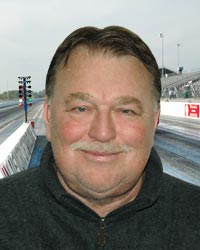|
|||||||||||||||||||||||||||||||||||||||||||||||||||||

Diapers, Britney Spears and pay-per-view
4/13/06

I’ve come to the conclusion that the biggest problem the professional sport of drag racing has isn’t cars going too fast, tires that shred, traction control or the cost of going racing. No, my fellow racers and fans, the problems are…oiling the track and no live TV!
The long, mind-numbing (not to mention costly) delays to repair the track after an oil-down not only makes the race day too long but drives spectators away and is probably responsible for keeping the sport from ever having another national event broadcast live. NASCAR fans get the Daytona 500 live on CBS and ABC broadcasts the Indy 500 flag to flag. One reason (ignoring the current Nielsen numbers) network executives won’t even think of broadcasting an NHRA event live is they know from past experience that after any fuel car goes down the track they could hear the announcer utter those dreaded words: “Uh oh, looks like Johnny Leakerparts’ Rambler Marlin Funny Car just put 20 quarts of synthetic oil right down the ol’ groove on that pass. Man, that fire was impressive, but it looks like a '20-bagger' clean-up, folks, so while we roll the trucks and farm tractors this would be a good time to head to the concession stand or take a nap!”
You can almost hear the remotes clicking before he finishes that sentence. Then for possibly the next 40 minutes or so, fans, the driver strapped into the car in the water box and maybe the home viewer are forced to watch tractors go up and down the lane while listening to (shudder) Britney Spears’ "Oops… I did it again" CD on the PA or psycho babble from announcers trying to be DJ’s and to entertain fans who came to see live drag racing with snappy patter. As for the director of a live TV broadcast of the race, well, his crew had better hide all of the sharp objects in the room from him.
I’ve been giving the issue of live TV broadcasts and watching track clean-up a lot of thought recently and I have a couple of ideas about both subjects. Ways the sanctioning bodies and all promoters might prevent most oil-downs (saving them some money) and make the sport more attractive to network TV (perhaps making them more money).
To paraphrase an old football rule, “You can’t expect to stop them, you can only hope to contain them." Nitro racers have proven that nothing is going to stop nitro engines from exploding, so the first order of business is for the industry to develop better containment devices that will cut oil-downs to an absolute minimum. The NHRA’s nitro guru Ray Alley has told his racers that they must have better containment devices.
The current SFI “diapers” for Pro cars are just $800 retail from Stroud and there are other manufacturers who are less expensive. However, cost isn’t the issue here. A three or four grand device that stop fluids from reaching the track would be a cheap price to pay for professional racers. There are inexpensive units available for sportsman racers and they are basically a one-time buy for them. I believe strongly that “diapers” ought to be considered a mandatory safety item just like roll cages, belts and firesuits.
Let's just assume that the industry does develop a device that drastically cuts down on the amount of oil and debris an engine failure puts on the track -- which will automatically make watching a major drag race a more enjoyable fan experience. How, you’re probably asking yourself, will that help get major drag racing events on live network TV?
Okay, here’s my formula. The NHRA has proven that if they don’t have a lot of delays for clean-up, crashes, etc., they can run two complete Pro qualifying sessions involving 75-80 cars in each session in about five hours. If they can accomplish that with 80 cars, they could easily run off three eight-car Pro fields in four hours or less, couldn’t they?
At NHRA’s premier events held in major markets like LA, New York, Chicago, and Las Vegas or at the sport's most recognizable race, the U.S. Nationals, they could develop a Sunday schedule with a four-hour block of live eliminations starting at noon for their Pro classes. In order to make it work they could have the first round of Pro eliminations on Saturday, leaving them with just eight cars in each Pro field on Sunday. If bikes are included, cut their field to just four. Offer the networks this package for a live broadcast in weekend prime time.
Four hours of live auto racing seems to be the magic number for the fans and the networks. This suggestion also allows the Saturday show to include professional eliminations, which means improved content, more exposure of casual race fans to real NHRA drag racing, and probably better ratings. And there is the benefit of possibly getting more media coverage of the professional classes with race results both Saturday and Sunday.
Running three rounds of eliminations in four hours could be difficult for the racers, but they are professionals and they will adapt. Drag racing is now about entertaining the fans first and catering to the racers a distant second. Professional racers will adapt to the situation.
The reality here is that whether anyone likes to admit it or not, professional drag racing is underexposed to the general public and it takes too long to finish a race. The largest venue in drag racing is the Pomona Fairgrounds which reportedly holds 44,000 people and it is the biggest stadium we have by a lot. A majority of NASCAR tracks hold over 100,000 fans.
Network executives know that drag racing is popular. We know this because of all of the made-for-TV drag racing shows like Pinks, Monster Garage and the dozens of shows produced by Ted Jones for ESPN. Drag racing is a great spectator sport. What gearhead doesn’t like fuel cars and 200-mph door cars that actually resemble what you see on the street? But no one in today’s society can stand to be a spectator of anything that takes all day to watch. Drag racing is going to have to find a way to present the essence of the sport in a shorter period of time (4 hours) if it’s ever going to be really popular with the auto racing masses.
|
So, I say build a better “diaper” that will keep oil and debris off of the track. Put 100 percent back in the tanks and let the rev-limiters do their job. Develop a race program that fits the attention span of today’s TV viewer and get drag racing back on live TV.
I’ll leave you with this thought. If the networks won’t televise a four-hour show from the U.S. Nationals, Winternationals, E-town or whatever then I say that the NHRA should take a page out of Vince McMahon’s playbook and offer pay-per-view. I’ll write the check now to see the final rounds of the U.S. Nationals from the Burk-a-lounger and I’ll bet a lot of other people would too. ![]()

